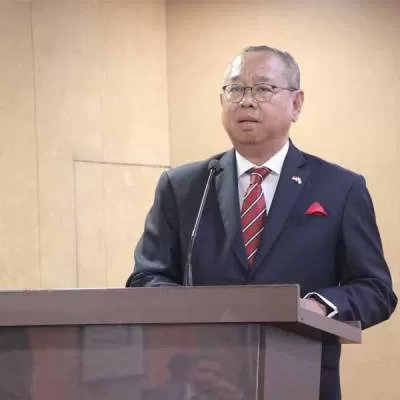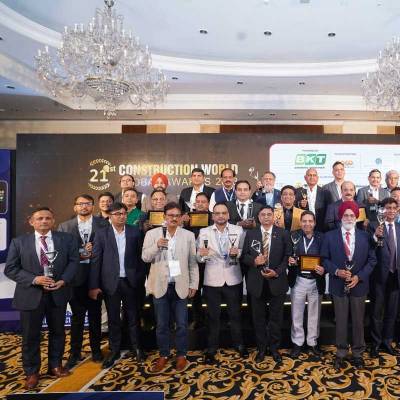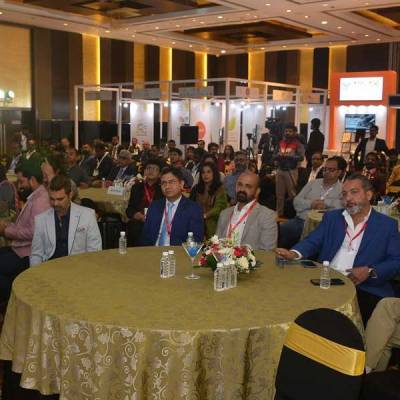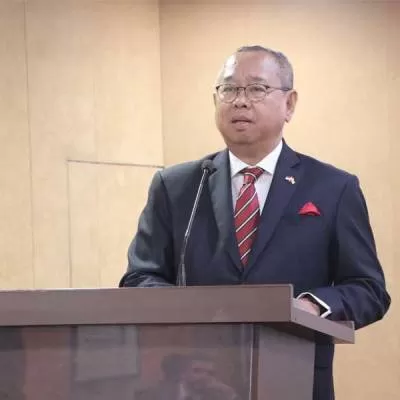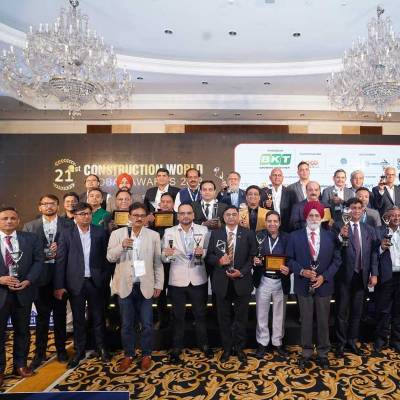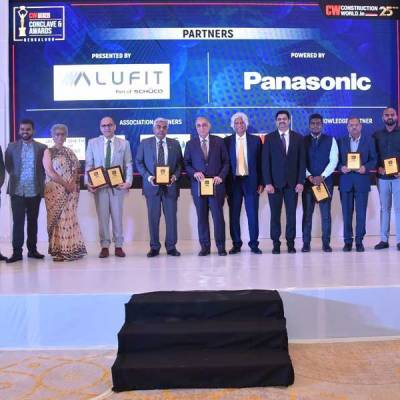- Home
- Real Estate
- What's Trending in Indian Workplaces? 13 industry stakeholders in Hyderabad discuss workplace design and technology and its impact on employee productivity

What's Trending in Indian Workplaces? 13 industry stakeholders in Hyderabad discuss workplace design and technology and its impact on employee productivity
Can efficient workplace design result into a retention tool, and how? After a series of roundtable discussions across cities in India, <span style="font-weight: bold;">CW</span> brought together the bigwigs of Hyderabad in a closed-room discussion to deliberate upon 'Workplaces of the Future'. The panel comprised 13 members, including consultants, architects, solution providers and others who play a key role in workplace design. Moderated by<span style="font-weight: bold;"> Falguni Padode, Group Managing Editor, CONSTRUCTION WORLD,</span> prominent points in focus during the discussion included planning and designing workplaces to enhance employee productivity, the role of smart technology and green measures, overall impact on work culture, and more. Excerpts: <p></p> <p> <span style="font-weight: bold;">Shashank Singh, Director & Head, Connected Lighting Business, Philips India</span> 'Hyderabad has always been a tech-savvy city. About five to six years ago, the lighting industry witnessed the techtronic trend; a shift from conventional source to LED lights helped save 60 per cent of energy. Today, we are looking at trends more human-centric and wellness-based; the industry has transformed with semi-conducted chips in lights, on the basis of which, you can do a lot of intelligence. Then, one started putting some amount of sensors into lighting. With chips capturing information and giving it back into the controlling action to either save energy or enhance the employee environment, and also to an extent to just dim the lights or match them to the circadian rhythm of the daylight, you can improve productivity. As part of wellness, buildings also consider daylight harvesting. While white light gives you more focus, warm light is more relaxing. This could lead to better productivity and benefits to employees in a workplace.'</p> <p> <span style="font-weight: bold;">Uday Sakunala, Director-IT and MIS, Hexagon Capability Center India </span>'From being in an independent house opposite the airport, we moved into a new building two years ago. It was a green project, and I was actively involved with my CEO, especially from an IT perspective. </p> <p>I was also with my admin team, who was simultaneously working there. We suggested green materials and all related factors were considered. When we were in the old office building, we wanted to do a rework several times. Today, we are talking about so much technology, but retrofit will be a big challenge. If we implement technology, how are we going to use it? We need to consider implementation versus usability. Moving on to cost, two years ago in the new office, we wanted LED bulbs; then we were talking about sensors and connecting them to the backend and switches. However, when I approached my CEO, and he looked at the amount to be invested, it was difficult for me to justify the returns that this will bring.'</p> <p> <span style="font-weight: bold;">Madan Kumar Sanisetty, Associate Director-FM and CRE, Dr. Reddy's Laboratories</span> 'Four years ago, our CEO hired an innovation team that involved six members, and he handed out a project to me for identifying space for them. In my first interaction, I understood that they wanted a temporary place for six months and then a permanent space. I took them around the offices we had then, and I realised they wanted a separate space for their team. We had five guesthouses and they agreed to work temporarily from one of them. But being an innovation team, they had some requirements. They wanted an open office without a desktop and chair kind of set-up; an attached kitchen with a dedicated chef and flexible job timings. The COO had given me clear instructions to give them what they wanted. It was later that I learnt that the aim was to a give a different experience to employees and to offer a different experience to users using Dr Reddy's products. We developed an open space with an attached open kitchen along with a play area within the office.'</p> <p> <span style="font-weight: bold;">Anamica Banerjee, Senior Associate Director-Project Management Group, CBRE</span> South Asia'Nowadays, people realise they do need a place where they can come and network. Socialising is part of our life, and hence, the new concept trending now is 'resimercial', where you give the concept of a residence but in a commercial space. Future workspaces will offer a homely environment, while giving us the independence to network with people from various organisations. </p> <p>Also, profitability is determined by two concepts: People and planet. Green certification and sustainability will add a lot of value to future buildings. </p> <p>We have a team that works on 360¦ wellness as it is important for an organisation to know how their employees are and what their emotional quotient is. Their happiness quotient will also come into the picture. In the future, artificial intelligence will definitely take place in our offices and innovation technology will help people be more productive.'</p> <p> <span style="font-weight: bold;">Srikanth Badiga, Group Director, Phoenix</span><br /> 'In 2003-04, there was a huge change happening in the Indian construction field. People started accepting BMS and innovations and technology; improvisations and so on all came in. Environment-friendly building materials, changing from conventional grids to hollow grids, using less glass, which leads to less heat ingress, requiring less HVAC, recycling water for HVACs... I am talking of small things that improved over a period of time. Most important, we do not want to cramp up our building. Traffic management and mechanical parking can be done. So these concepts have to be considered while designing workplaces. How are you going to be digitally present, how are you going to enable them to be present digitally and how will they consume services digitally? Now, when you are moving between workplaces, you need to be seamless. That is not going to be easy because it needs a lot of infrastructure enablement and the planning has to be done.'</p> <p> <span style="font-weight: bold;">Srinivas Rao Laggani, Executive Director, Technoflair Solutions</span><br /> 'It is important to retain the personality of the organisation and behaviour of the people. We have done a project for a specific client who wants small offices rather than a bigger one. He started thinking about how we always have an easy way to do a huge office and make a unique brand value to that in terms of architecture and programmers. When it comes to small offices, you have to maintain the uniqueness of the individuality. So we have tried to do something on those lines. It is a new construction spread across 10 lakh sq ft. </p> <p>It has its own façtade, which is unique; at the same time, there is a language across the buildings, wherein, you project the whole office as one in terms of the usual elements.'</p> <p> <span style="font-weight: bold;">Dheeraj K, LEED Green Associate, IGBC AP, and Sr Engineer-Consulting Team, TS and AP, Conserve Consultants</span><br /> 'Ironically, we foresee that there will be no future workplaces. Over the decades, with the way our workplaces have taken a radical shift from cubicles to open stations, people are now talking about collaborative workspaces, open office workstations and flexible workstations. So, how we design the workplace has become crucial. Over the past decade, the focus has been on energy-efficient buildings. But is this catering to people who are staying in the building, because 90 per cent of our time would be spent indoors. So the challenge is addressing these indoor spaces to be futuristic. There is a beautiful concept in sustainability called triple bottomline, which is a tripod in the design. In planning and designing a workplace, it is important to not just put intelligence or artificial intelligence into the design but emotional intelligence. This is conceptualised into several zones with occupant well-being and comfort. Also, considering that design implementation intends to make profit out of the business, we need to do that by bringing in the biophilia concept and artificial intelligence.</p> <p> <span style="font-weight: bold;">Praveen Upadhyay, Head of Facilities & EHS, Hyderabad Campus & Bengaluru, Virtusa</span><br /> 'Two years ago, we had only one campus globally, which was in Hyderabad. There were two aspects to its planning and design. One is that if you have your own campus, you get more leverage to build whatever you want. If we have our own campus, we can think about landscaping, a solar plant for renewable energy, and can build a nice cafeteria, gym, chill-out areas, etc. Also, every organisation looks for the bottomline. So, we first want a workstation that is a revenue generator. </p> <p>This is followed by amenities for employees to help them work. Technology will help because millennials are so pro-mobile and gadget-friendly. </p> <p>When we talk about IoT-based solutions for chillers, we will get savings of 10 per cent on that. We will check for lighting and HVAC, followed by preventive maintenance for critical equipment. Then, we talk about future smart materials. We have to make lighting, HVAC and integration of utilities; we have BMS where all utilities are connected. So the future workplace will be an office where the camera captures my car number plate as it enters and books a parking slot for me. You have charging stations, electric vehicles, and an open office.'</p> <p> <span style="font-weight: bold;">S Srinivas, Deputy Executive Director, Confederation of Indian Industry (CII)</span><br /> 'When we got ITC on board, we demonstrated that from a projected energy of 32 lakh units per year, with green features, this was brought down to 20 lakh units per year. The other early movers were Wipro. </p> <p>With 500 employees sitting in a space in Gurugram, the company first decided to do the building and see the benefits. Once the building was done and people moved in, their energy consumption came down from 55 lakh units per year to almost 35 lakh units per year. Also, today, there are almost 10 to 12 state governments encouraging green buildings. </p> <p>We are working on a concept called net-zero energy, water and waste. In the coming months, our own building will become a net-zero energy building, and this will set the tone in having a net-zero movement in this country. Today, it has been realised that even if you increase 1 per cent employee productivity in an IT office, the amount of savings you get in terms of their productivity and salaries will out-beat the energy these buildings consume.'</p> <p> <span style="font-weight: bold;">Sridhar Jayaraman, Senior Manager, Technology & Solutions, L&T Construction Smart World & Communication</span><br /> 'Everybody works for business, and at the end of the day you need to earn for your business to run. But we really need to think about what we are going to deliver after 30 years. Our solutions being talked about are to help the business to grow while helping the nation to come up at the same time. As an IT company, we try to build at 60 per cent as green; we wanted to have an open environment. </p> <p>We also wanted a war room kind of a set-up with many meeting rooms enabled digitally. In terms of integration, we talk about the BMS solution today. Initially, when we wanted to integrate our air-conditioning into the BMS,it was a challenge but a lot has changed since. Today, I know of someone who has to work for one week as a network engineer in his company. </p> <p>The remaining three weeks, he is allowed to go and take on any soft skill. But that one week, he has to work 24 x 7 and ensure the network is working.'</p> <p> <span style="font-weight: bold;">Dhurgai Kumaran SSN, Director-Studio, FHD Group</span><br /> In 2010, I was in Stockholm, Sweden. I visited my client's office and was astonished. It was a rich heritage building and there was not a single light in the office. The office is designed for natural light and does not require any artificial lighting. Since then, I have wanted at least one office in India to have a similar design. Our environment may not permit the same as we have hot weather conditions. But lighting is one aspect we can afford. </p> <p> So, I have segmented construction into three segments, irrespective of the verticals. First is a start-up segment, second is SME, and the third is large corporate. While the major focus is on a bigger space, the challenge, today, in India, is a good quality workplace for a start-up at an affordable price. So, there is a significant need for incubation centres in future. The focus on creating co-working spaces with good technology facilities will definitely have a wonderful opportunity to scale up.'</p> <p> <span style="font-weight: bold;">Jayaraman Ravikumar, CFO, L&T Metro Rail (Hyderabad)</span><br /> 'Building a good workplace is equal to building an infrastructure facility in India. Execution in both cases is complex. The meaning of the term 'productivity' has evolved over a period of time. About 15 to 20 years back, the focus was more on output. You increase the output, reduce the cost and your profit goes up automatically. Later on, the definition underwent a change - that it is not the quantity you need to focus on but the quality. There has been constant thinking, revisiting, introspection and SWOT analysis and we also have a different idea to add value. So, we do not build a colourful building, we 'design' the people. We see if each person is a cultural fit for the organisation. We try to make the environment in such a fashion that the person will not bend down on seeing the challenge. We have an intellectual programme. Hence, the workplace is not only a building consisting of bricks and cement. Building a proper workplace is possible only by training the people and mentoring them properly to createleaders.'</p> <p> <span style="font-weight: bold;">Yousuf Kamaal, Director, SWBI Architects</span><br /> 'The simple traditional BPO set-up had a rigid framework with a BPO desk and enclosures. The same clients are coming back to us and taking it to a wider project. So, we are making certain pilot projects, where more knowledge-based workers will be there instead of the processes. We are doing one large campus for Bank of America. You do not have a fixed seat. Technology follows you. You land up into the reception and point your QR code; it shows you which meeting room you need to go to. Specific areas have become a work café - the work-from-anywhere concept. For a banking sector, this is a unique concept. Going forward, things will be tailor-made to culture and locations. The next cycle is going to be more about delivering value. Almost all leading organisations are waking up to this activity-based working. It will go a little further when data, artificial intelligence and virtual reality also come into play. Workstations and traditional meeting rooms are going to disappear.'</p> <p> <span style="font-weight: bold;">- SHRIYAL SETHUMADHAVAN</span></p>


